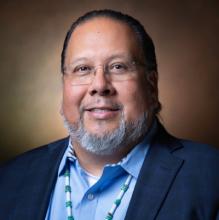
Stephen Roe Lewis
Stephen Roe Lewis was raised in Sacaton, “Gu-u-Ki”, on the Gila River Indian Community. His father is the late Rodney Lewis and mother Willardene Lewis. Mr. Lewis has a son, Daniel currently attending Arizona State University.
Mr. Lewis is in his third term serving as Governor of the Community, having previously served as Lt. Governor. Prior to serving in elected leadership, Governor Lewis served the Community as a member of the Board of Directors for the Gila River Healthcare Corporation, as a Gaming Commissioner for the Gila River Gaming Commission, and as a member of the Board of Directors for the Gila River Telecommunications, Inc. Stephen Roe Lewis graduated from Arizona State University with a Bachelor’s of Science and pursued graduate studies at John F. Kennedy School of Government at Harvard University.
Governor Lewis currently oversees the implementation of the Community’s Water Settlement of 2004 (at that time the largest water settlement of its kind in United States history). Governor Lewis advocates for renewable and green technologies guided by O’odham agricultural history and cultural teachings. Governor Lewis’s vision is to support a new generation of Community member agriculturalists with the goal of promoting and protecting the Community’s shudag (water) and agricultural development.
During his tenure as Governor of the Gila River Indian Community, Governor Lewis has brought innovative solutions to long-standing issues that will create long-term gains for the Gila River Indian Community. One of these projects, Management Aquifer Recharge sites, brings together the need for access to water while restoring the return of the Community's riparian area which is vital for farming and the return of wildlife to the Community. Bringing back the Gila River, which is critical to the culture and identify of the Gila River Indian Community, has been a key milestone during Governor Lewis' Administration and one that will lay the foundation for future projects across the Community.
In addition, Governor Lewis' innovation can be seen in his approach to providing educational opportunities for the youth of the Gila River Indian Community. The Community was the first tribal community in the Nation to utilize the Indian Self-Determination and Education Assistance Act to create a program that revolutionized how infrastructure is constructed and maintained throughout Indian Country. This program, the Section 105(l) program was utilized for education construction in the Community, and the Community is working to expand the uses of the program to other infrastructure in the Community and throughout Indian Country.
Governor Lewis has also prioritized the Community’s Veterans and youth by working to establish the Community’s first Veteran’s and Family Services Department and by committing more resources to protect the Community’s children by advocating for the protection of the Indian Child Welfare Act both at home and nationally.
These projects illustrate the commitment that Governor Lewis has to respecting the history and culture of the community while providing for a brighter future for all of the Community's citizens.
In addition to his leadership in the Community, Governor Lewis has worked on numerous political campaigns and organizing projects throughout Indian Country including serving as an elector for the 2020 Presidential election and selected as an Arizona delegate and Co-Chair of the Native American Caucus for the 2012 Democratic National Convention in Charlotte, North Carolina.
Governor Lewis was the first Native film curator for the Sundance Film Festival in Park City, Utah and was an Associate Producer for the groundbreaking and critically acclaimed TBS six-part feature documentary, “The Native Americans.”
Governor Lewis proudly serves as the Secretary of the National Congress of American Indians, President of the Arizona State University’s American Indian Policy Institute Board of Directors, on the Executive Board for the National Indian Gaming Association (NIGA), and on the Board of Trustees for the Heard Museum of Phoenix.